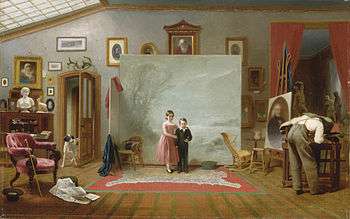Thomas Le Clear
Thomas Le Clear (born in Owego, New York, 17 March 1818; died in Rutherford, New Jersey, 26 November 1882) was an American painter.

Biography
Le Clear sold his first paintings, copies of a painting of Saint Matthew, at the age of 12.[1] He began to follow art professionally before he had had any instruction. He continued to teach himself by studying the painting by other artists. When he was fourteen, in 1832, he moved to London, Canada, with his father. He painted portraits there for a time. He painted portraits in Elmira, and in Rochester, before moving to New York City in 1839, when he was twenty-one. There he studied for several years under Henry Inman.[1] From 1844 to 1860, he resided in Buffalo, where he was a founding member of the Buffalo Fine Arts Academy. He returned to New York City in the early 1860s, and was elected a National Academician in 1863.[1]
Le Clear died of pleurisy on November 26, 1882, at his home in Rutherford, New Jersey.[2]
Works
Among his compositions are “The Reprimand,” “Marble Players,” and “Itinerants” (1862). Of his numerous portraits, one of the best is that of George Bancroft, at the Century Club, New York; other excellent portraits are those of William Cullen Bryant, Bayard Taylor, Millard Fillmore, and Edwin Booth as Hamlet. He's also noted for his genre scenes, including Interior with Portraits.
Notes
- "Thomas Le Clear/American Art". National Museum of American Art (CD-ROM). MacMillan Digital in cooperation with the National Museum of American Art. 1996. Retrieved 10 August 2012.
- "THE DEATH-LIST OF A DAY; THOMAS LE CLEAR THE FAMOUS PORTRAIT-PAINTER.", The New York Times, November 28, 1882. Accessed November 19, 2017. "Thomas Le Clear, one of the most famous of the portrait-painters which this country has produced, died at his residence in Rutherford, N.J., on Sunday evening."
References
- This article incorporates text from a publication now in the public domain: Wilson, J. G.; Fiske, J., eds. (1892). . Appletons' Cyclopædia of American Biography. New York: D. Appleton.
| Wikimedia Commons has media related to Thomas Le Clear. |